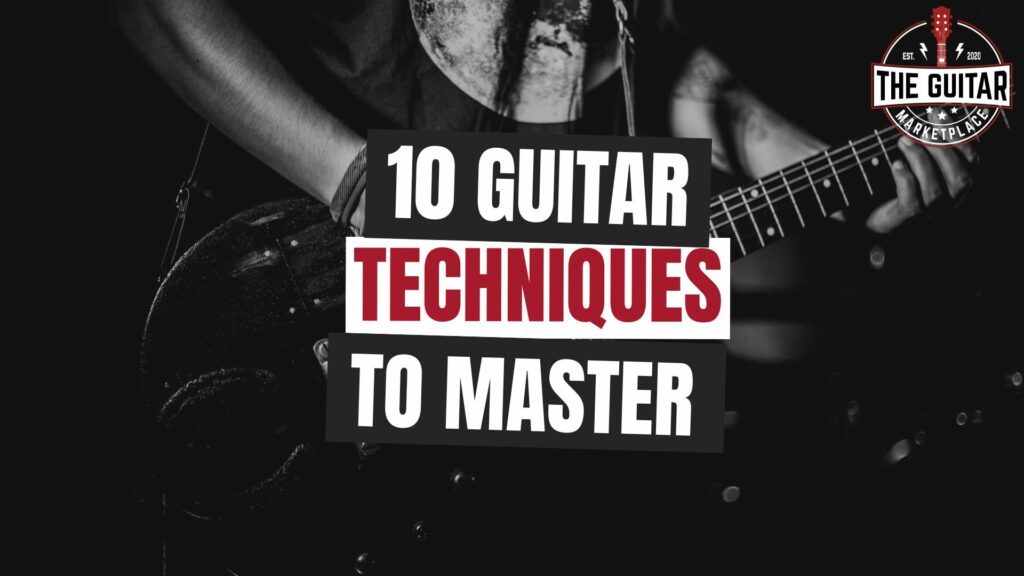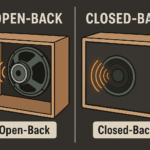Mastering essential guitar techniques is crucial for any guitarist looking to enhance their playing skills. In this article, we will explore ten fundamental techniques that every guitarist should strive to master. Whether you’re a beginner or an experienced player, these techniques will provide a solid foundation for your guitar journey. After each explanation of the technique we will include a video demonstration of the technique.
I. Guitar Technique 1: Alternate Picking
Alternate picking is a technique where you alternate between downward and upward strokes. It not only helps in increasing speed and accuracy but also improves your overall control and articulation. The video below delves into the benefits of alternate picking, its applications in different musical styles such as rock, metal, and jazz, and provide tips for improving your alternate picking skills. Additionally, you should understand the importance of synchronisation between your picking hand and fretting hand to achieve clean and precise alternate picking patterns.
Example:
II. Guitar Technique 2: Hammer-ons and Pull-offs
Hammer-ons and pull-offs are essential techniques that allow you to create smooth, legato phrases. A hammer-on involves using a finger of the fretting hand to “hammer” onto a higher fret, producing a clear note without picking it again. Conversely, a pull-off is when you “pluck” a higher fretted note with a finger of the fretting hand, creating a seamless transition to a lower note. The video below will define and demonstrate these techniques, share examples of songs that utilise them effectively across various genres, and provide exercises to enhance your hammer-on and pull-off proficiency. Also you can explore techniques like trills and combinations of hammer-ons and pull-offs for more advanced players.
Example:
III. Guitar Technique 3: Bending
Bending is a technique that adds expression and emotion to your guitar playing. By pushing or pulling a string, you raise or lower its pitch, creating a vocal-like quality. The video below will explain different bending techniques, such as whole-step and half-step bends, and discuss the importance of intonation and pitch control. Additionally, it delves into various bending styles and explore how bending is used to add nuance and feeling to solos and melodies. Through exercises and practical tips, we’ll guide you in achieving accurate and expressive bends while maintaining a clean and controlled sound.
Example:
IV. Technique 4: Vibrato
Vibrato is a subtle yet powerful technique used to add character and emotion to notes. It involves small, rapid variations in pitch that create a “wobble” effect. Vibrato adds expressiveness to your playing, explore various vibrato styles such as wrist vibrato and finger vibrato, and provide exercises to develop control and expressiveness in your vibrato technique.
Example:
V. Guitar Technique 5: Slides
Slides can add fluidity and interest to your playing, creating smooth transitions between notes and adding a unique flavor to your melodies and solos. The video below will explain how slides work, including both ascending and descending slides, and discuss different slide techniques such as legato slides and slide bends. It showcases examples of songs that effectively use slides across various genres, from blues to rock to country, and offer tips for executing smooth and accurate slides. Additionally, we’ll explore techniques like double stops and slide harmonics for more advanced players.
Example:
VI. Guitar Technique 6: Palm Muting
Palm muting is a technique that creates a percussive, muted sound by lightly resting the side of your picking hand near the bridge of the guitar. It is commonly used in genres like rock, punk, and metal to achieve a tight and controlled sound. The video below will define palm muting, discuss its applications in different music genres, and provide techniques for achieving clean and controlled palm muting. We’ll explore the concept of palm muting dynamics and show how varying the pressure of your palm can create different tonal qualities. Check out the video below for exercises to help you develop precision and consistency in your palm muting technique.
Example:
VII. Guitar Technique 7: Fingerpicking
Fingerpicking allows for intricate melodies, complex chord progressions, and simultaneous bass lines, providing a fuller and more versatile sound. The video below will provide an overview of fingerpicking technique, discuss the advantages of fingerpicking, and offer exercises and patterns to enhance your fingerpicking dexterity. It will show different fingerpicking styles like classical, folk, and flamenco, and showcase how fingerpicking can be used to create beautiful arrangements and express intricate musical ideas.
Example:
VIII. Guitar Technique 8: Sweep Picking
Sweep picking is a technique used in fast and fluid arpeggio playing, often associated with genres like shred and metal. It involves using a combination of picking and rolling motions across multiple strings to produce a rapid succession of notes. The video below explains the sweep picking technique, highlight notable guitarists known for their sweep picking skills, and provide exercises to help you master this challenging technique. It discusses the importance of economy of motion, synchronization, and finger placement in achieving clean and effortless sweep picking patterns.
Example:
IX. Technique 9: Tapping
Tapping involves using your fingers to produce notes on the fretboard, creating a unique and distinctive sound. Popularized by guitar virtuosos like Eddie Van Halen, tapping opens up a world of possibilities for creating fast and intricate patterns. The video below explores tapping, showcase iconic tapping songs and solos, and provide tips for practicing and incorporating tapping into your playing. The video offers exercises to help you develop finger independence, accuracy, and speed in your tapping technique.
Example:
X. Guitar Technique 10: Hybrid Picking
Hybrid picking combines the use of a pick and fingers to achieve a unique sound, providing greater flexibility and options for both rhythm and lead playing. The video below will define hybrid picking, discuss its benefits, present examples of songs that utilise hybrid picking, and offer exercises to develop accuracy and coordination in your hybrid picking technique. It explores hybrid picking patterns, string skipping, and integrating hybrid picking with other techniques such as alternate picking and fingerstyle. Additionally, the video shows how hybrid picking can be used to create interesting and dynamic phrases across various genres.
Example:
Guitar Techniques:
Mastering these ten essential guitar techniques will undoubtedly elevate your playing abilities and open up new creative possibilities. Remember, practice and consistency are key to mastering any technique. So, grab your guitar, dive into these techniques, and embark on an exciting journey of musical growth and expression. As you build a strong foundation with these techniques, you’ll find yourself becoming a more versatile and confident guitarist, capable of expressing your unique musical voice. Enjoy the process, experiment, and most importantly, have fun as you explore the vast world of guitar playing.
To see more guitar techniques and how to learn them check this other blog by PMT
CHECK OUT OUR LATEST COMPETITIONS HERE
-
 Boost Your Odds – Win Tickets Instantly!£1.99Per Entry
Boost Your Odds – Win Tickets Instantly!£1.99Per Entry -
 Taylor GS Mini-e Special Edition Electro-Acoustic in Silverburst£0.99Per Entry
Taylor GS Mini-e Special Edition Electro-Acoustic in Silverburst£0.99Per Entry -
 Jackson SL7Q Pro Soloist in Alien Burst Green£2.99Per Entry
Jackson SL7Q Pro Soloist in Alien Burst Green£2.99Per Entry -
 Taylor 814ce Grand Auditorium£3.99Per Entry
Taylor 814ce Grand Auditorium£3.99Per Entry -
 PRS USA John Mayer Silver Sky Silver in Tungsten£0.30Per Entry
PRS USA John Mayer Silver Sky Silver in Tungsten£0.30Per Entry -
 Ibanez S621QM in Saphire Blue Flat£0.07Per Entry
Ibanez S621QM in Saphire Blue Flat£0.07Per Entry -
 Epiphone Limited Edition Les Paul Custom Widow In Indigo Burst£0.99Per Entry
Epiphone Limited Edition Les Paul Custom Widow In Indigo Burst£0.99Per Entry -
 Fender guitarguitar Exclusive Player II Telecaster Roasted Maple Fingerboard in Charcoal Frost Metallic! Same-Day Delivery in the TGM Bus£1.25Per Entry
Fender guitarguitar Exclusive Player II Telecaster Roasted Maple Fingerboard in Charcoal Frost Metallic! Same-Day Delivery in the TGM Bus£1.25Per Entry -
 Free Wild Wednesday Giveaway! Spend £0 & Win a Mooer PRIMES1 Multi-FX or Spend £5+ & Win a Line 6 Pod Go Multi-FX£0.00Per Entry
Free Wild Wednesday Giveaway! Spend £0 & Win a Mooer PRIMES1 Multi-FX or Spend £5+ & Win a Line 6 Pod Go Multi-FX£0.00Per Entry







